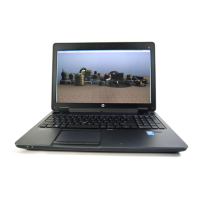Do you have a question about the HP Zbook Firefly 15 G8 and is the answer not in the manual?
Use touch gestures on the touchpad or screen to navigate and control the computer.
Learn about the computer's power-saving states: Sleep and Hibernation.
Enable, initiate, and exit Hibernation for power saving.
Properly shut down the computer to conserve power and prevent data loss.
Enhance computer performance through regular maintenance tasks.
Update programs and drivers regularly for improved features and issue resolution.
Create and manage passwords to protect computer information and online transactions.
Set and manage user and administrator passwords for Windows accounts.
Set administrator and power-on passwords for the BIOS Setup Utility.
Protect your computer from online threats with up-to-date security software.
Detect, remove, and repair damage caused by computer viruses.
Prevent unauthorized access to your system or network using firewall software.
Regularly install Windows and third-party software updates for security and performance.
Enable security features to protect your network from unauthorized access.
Regularly back up applications and information to prevent data loss.
Access the BIOS Setup Utility by pressing specific keys during startup.
Download the latest BIOS update from the HP website and prepare for installation.
Run diagnostic tests within Windows to determine hardware functionality.
Run diagnostic tests outside the OS to isolate hardware failures.
Use Windows tools to back up personal information and create restore points.
Create recovery media using HP Recovery Manager or HP Cloud Recovery Tool.
Create recovery media using HP Recovery Manager and understand its requirements.
Explore options for restoring, refreshing, and resetting the computer.
Recover the Windows partition to its original factory state.
Restore the computer to its original factory state, deleting all data.
Use HP Recovery Manager to restore the computer to its original factory state.
Perform system recovery using the HP Recovery partition (select products only).
| RAM | Up to 64 GB DDR4-3200 SDRAM |
|---|---|
| Storage | Up to 2 TB PCIe NVMe SSD |
| Processor | Intel Core i5 or i7 processors |
| Graphics | Intel Iris Xe Graphics |
| Display | 15.6" FHD (1920 x 1080) |
| Operating System | Windows 10 Pro |
| Battery | 3-cell, 56 Wh Li-ion polymer |
| Weight | Starting at 1.7 kg |
| Dimensions | 35.94 x 23.39 x 1.92 cm (14.14 x 9.21 x 0.75 in) |
| Ports | HDMI 2.0, headphone/microphone combo, AC power |
| Wireless | Intel Wi-Fi 6 AX201 (2x2) and Bluetooth 5 combo |











